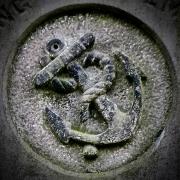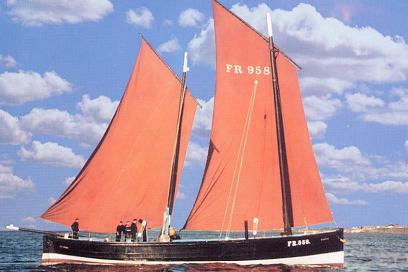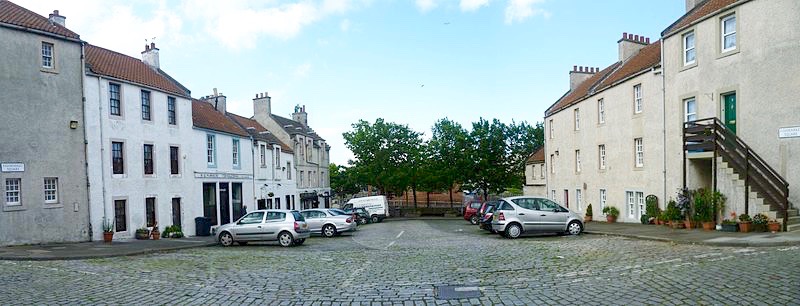
The Great Storm of 14 October 1881 claimed the lives of 189 men, most of them fishermen from Eyemouth (129) and Burnmouth (24), but 17 originating from Newhaven.
Three of those Newhaven men are remembered on adjacent gravestones in Rosebank Cemetery:
- David Stevenson, a 58-year-old pilot ‘drowned near Dunbar’ and not recovered for burial until four-and-a-half months later
- Hugh Stevenson (another pilot and David’s eldest son), aged 32
- Philip Stevenson (again a pilot, buried on the same day as his father), aged 30.


The hard-to-decipher inscription at the foot of David and Hugh’s stone reads:
THE CONFLICT IS OVER, THE VICTORY’S WON
HE IS RESTING IN JESUS, HE IS RESTING AT LAST.
THE BILLOWS THAT FILLED HIS SOUL WITH ALARM
ARE HUSHED AND HE’S SAFELY ANCHORED AT LAST.
Calm (and need) before the storm
The morning of 14 October dawned bright and calm, but there had already been predictions of a severe gale in the offing. Eyemouth’s fishermen – under financial pressure to take risks due to a long-standing dispute over tithes with the Church of Scotland and the costly disrepair of their harbour – ignored the warnings and put to sea.
Late that morning, the wind dropped to a dead calm before the storm struck suddenly.
It rapidly reached Storm Force 9/10 (locally Violent Storm Force 11) and most of the boats that weren’t immediately capsized struggled back towards home. Tragically, just 50 yards outside Eyemouth and unable to make port at low tide, many of the crews were drowned or battered to death on the Hurkar Rocks in full view of their horrified wives and children.
It is not clear, at this remove, exactly why the Stevensons and other Newhaven crews set out. David was permitted to pilot his yawl – ‘Stormy Petrel’ – between the Tay and the Tweed, but was chiefly employed from Dunbar to the Roads between Inchkeith and Leith Harbour. Perhaps in foul weather there would have been more likelihood of him finding a vessel requiring help.
[Image below is of a 19th-century Fifie-class fishing yawl, typical along the Scottish East Coast. From: Wikipedia, Creative Commons.]

A Newhaven tragedy
Two days later, the Edinburgh Evening News reported on the local impact:
A deep gloom prevails in the fishing village of Newhaven, where, out of over 400 hundred fishermen, 17 have perished in the storm.
The incidents connected with the loss of these men, which almost all took place in the vicinity of Dunbar, have already been recorded and there is little new to add regarding them. Many bodies found near Dunbar were brought back to Newhaven but some were never recovered at all. In all 44 children will be left unprovided for by these losses.
Some names of those killed or missing;–
Pilot Boat ‘Concord’ – crew – John, James and Walter Johnston. ‘The Perseverance’ (the largest boat) – crew – John Carnie, Boreas Hall, William Inglis, Peter Inglis, John Wilson, John and David Lyle. 10 Children left unprovided for from this boat alone. ‘The Robinas’ – a boat 24 feet in length and missing – crew – William Rutherford, Matthew Hume (age 18), William Liston (age 17) and Alexander Noble who leaves nine of a family. ‘The Stormy Petrel’, a pilot boat, left Dunbar on Friday morning and is also missing – crew – father and two sons – David Stevenson, Hugh Stevenson and Philip Stevenson.
A Mr Merrilees from Newhaven, who has been along the coast as far as Dunbar in his carriage, picked up the mast, tiller, rigging, compass-box, a cravat and stocking belonging to the pilot boat ‘Stormy Petrel’, which was lost on the passage home from Dunbar. A total of 12 children will also be left unprovided for from this vessel.
In fact, private subscriptions to a relief fund eventually raised over £50,000 (estimated at around £4.5 million in today’s terms) for the 93 widows and 267 orphans left behind.
[Image below is of Fishmarket Square, Newhaven. By Kim Traynor, Creative Commons.]

Further sources of information
The remarkable edinphoto website has photographs of a framed remembrance to the three Stevensons in the possession of David’s great-grandson John. Births, marriages and deaths for other members of the family are listed here.
The event – subsequently known as ‘Black Friday’ along the Berwickshire coast – was portrayed by the Edinburgh artist J. Michael Brown in 1882. It featured here on BBC1’s Antiques Roadshow in 2013.
----------------------
 Donna Caldwell There's a beautiful tapestry commemorating the storm and loss of life in Eyemouth Museum.
Donna Caldwell There's a beautiful tapestry commemorating the storm and loss of life in Eyemouth Museum.



